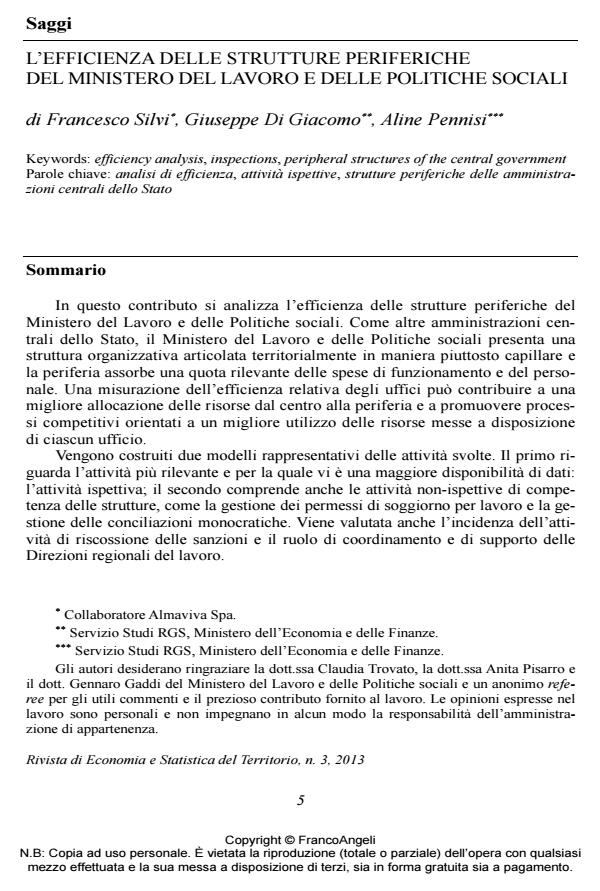L’efficienza delle strutture periferiche del ministero del lavoro e delle politiche sociali
Journal title RIVISTA DI ECONOMIA E STATISTICA DEL TERRITORIO
Author/s Francesco Silvi, Giuseppe Di Giacomo, Aline Pennisi
Publishing Year 2014 Issue 2013/3
Language Italian Pages 40 P. 5-44 File size 1043 KB
DOI 10.3280/REST2013-003001
DOI is like a bar code for intellectual property: to have more infomation
click here
Below, you can see the article first page
If you want to buy this article in PDF format, you can do it, following the instructions to buy download credits

FrancoAngeli is member of Publishers International Linking Association, Inc (PILA), a not-for-profit association which run the CrossRef service enabling links to and from online scholarly content.
The paper analyzes the efficiency of territorial offices of the Ministry of Labour and Social Policy, which use an high portion of the financial and human resources of the Ministry. The aim is to compare their efficiency in order to improve resource allocation from the center to the periphery and to promote competitive behavior on the better use of available resources among the offices themselves. Methods and Results: Two models are examined, both based on a non-parametric Data Envelopment Analysis (DEA) approach with bootstrapping techniques. Margins for a reallocation of resources and an increase of productivity are examined through a slack analysis. The first model concerns the inspection services carried out by the territorial offices on enterprises as concerns the labour and social security regulation enforcement an on construction sites, for security and health regulations. The second model also considers other activities such as the issuing of work permits for migrants and resolving disputes between employees and employers before lawsuits. Further specifications include collection of fines and the role of the higher-level regional offices. The results show a relatively high average performance of the territorial offices, albeit significantly different rankings among the models. The inclusion of regional coordination and support does not seem to modify relative efficiency scores. The second, more complete, model shows scale economies; while efficiency does not appear to be driven by the typical Italian North-Center-South divide. Conclusions: Albeit their complexity and multiple functions, estimating and analyzing the efficiency of the Ministry of Labour and Social Policy’s territorial offices can provide useful insights also for productivity enhancement and cost rationalization. While there seems to be little margin to reduce inputs, if all offices were equally efficient, there could be relevant gains in terms of some of the activities carried out.
Keywords: Efficiency analysis, inspections, peripheral structures of the central government
Jel codes: D24, H11
- European Social Fund’s Lifelong Learning and Regional Development: A Case Study Francesca Volo, Alessandra Drigo, Bruna Zolin, Domenico Sartore, in SSRN Electronic Journal /2019
DOI: 10.2139/ssrn.3333902 - Competition and Regulation in Italy Magda Bianco, Silvia Giacomelli, Giacomo Rodano, in SSRN Electronic Journal /2012
DOI: 10.2139/ssrn.2064682 - Le normative e le politiche regionali per la partecipazione delle donne al mercato del lavoro (Regional Laws and Policies for the Participation of Women in the Labour Market) Maria Lucia Stefani, Aimone Gigio Luciana, Giuseppe Albanese, Monica Amici, Marta Auricchio, Rosario Maria Ballatore, Carla Bertozzi, Manuela Calderini, Liliana Centoducati, Nicola Curci, Petra Degasperi, Silvia Del Prete, Pietro De Matteis, Sabrina Lucia Di Addario, Elena Gennari, Sabrina Ferretti, Giovanna Firpo, Michele Loberto, Claudio Salvatore Loreto, Elisabetta Manzoli, Vincenzo Mariani, Daniela Mele, Patrizia Passiglia, Achille Puggioni, Sonia Soncin, Giulia Tanzi, Anna Verrengia, Giovanni Vittorino, in SSRN Electronic Journal /2013
DOI: 10.2139/ssrn.2303662 - Housing Affordability Index: Real Estate Market and Housing Situations Leopoldo Sdino, Paola Castagnino, in Advanced Engineering Forum /2014 pp.527
DOI: 10.4028/www.scientific.net/AEF.11.527 - Did the Governance of EU Funds Help Italian Regional Labour Markets during the Great Recession? Roberta Arbolino, Paolo Di Caro, Ugo Marani, in JCMS: Journal of Common Market Studies /2020 pp.235
DOI: 10.1111/jcms.12900
Francesco Silvi, Giuseppe Di Giacomo, Aline Pennisi, L’efficienza delle strutture periferiche del ministero del lavoro e delle politiche sociali in "RIVISTA DI ECONOMIA E STATISTICA DEL TERRITORIO" 3/2013, pp 5-44, DOI: 10.3280/REST2013-003001